Dorylus (Anomma) kohli Wasmann
  Type location Zaïre
(Dorylus (Anomma) kohli n.
sp., Wasmann, 1904b: 669, workers; Santschi, 1921c: 114, soldier) St
Gabriel, Stanleyville [Kisangani], P Kohl - see below Type location Zaïre
(Dorylus (Anomma) kohli n.
sp., Wasmann, 1904b: 669, workers; Santschi, 1921c: 114, soldier) St
Gabriel, Stanleyville [Kisangani], P Kohl - see below
subspecies
minor (Dorylus
(Anomma) Kohli Wasm. v. minor
n. var., Santschi, 1911g: 206, worker) from Angola,
collected at Benguela, by J Cruchet - see http://www.antweb.org/specimenImages.do?code=casent0911300
chapini (Dorylus
(Anomma) kohli variety chapini,
new variety, Wheeler, 1922: 45)
from Zaïre - see below.
frenisyi (Dorylus
(Anomma) Kohli Wasm. v. Frenisyi
n. var., Forel, 1916: 402, worker) from Zaïre (Congo), Kohl
(Raignier & van Boven, 1955) - see below.
workers and queen known  . .
Note - the Antweb photographs (released ix.2012)
of Dorylus
erraticus F Smith, 1865, appear to show that matches the media
worker of what I see as kohli from Guinea. If correct erraticus
could be argued as the senior synonym.
|
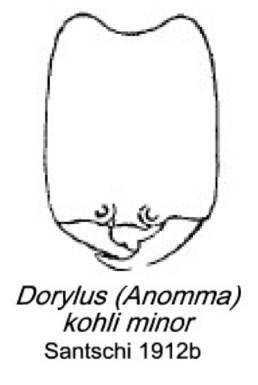 Wasmann's
description (1904b), of worker TL 3-8 mm, is
at Wasmann's
description (1904b), of worker TL 3-8 mm, is
at  . Santschi (1921c) gave a description of
the major - . Santschi (1921c) gave a description of
the major -  . Santschi's (1911g)
description of minor is at . Santschi's (1911g)
description of minor is at  . Boven (1968: 731) described the queen and
gave notes; this is at . Boven (1968: 731) described the queen and
gave notes; this is at  . .
|
Raignier & van Boven summarized the descriptions as
- head practically rectangular, wider and a little more scalloped
posteriorly; petiole slightly longer than wide (Santschi). The worker
media (Wasmann) head narrowing towards the rear; almost matt dorsally;
petiole as wide as long and equally wide at both ends. Worker minima (3
mm) with 11-segmented funiculus, petiole as long as wide at its base
but narrowing towards the front. Majors red-brown, red-yellow paling
with smaller morphs. Forel (1909b) noted that Dorylus kohli was
more robust, shinier and with shorter appendages than emeryi.Wheeler
(1922) gave a description of chapini (given below).
Raignier & van Boven (1955) examined the types of frenisyi
and considered them probably no more than the minor morphs of kohli
s.s. From Forel's (1916) very brief description, with a TL 4-8.5
mm, etc., I agree.
In their own field work, Raignier & van Boven made
one collection of kohli s.s., with 5 workers, TL 11-3 mm; major
- CI 91, petiole as wide as long, scape width/length = 22 (relatively
slender); practically glabrous and red to red-brown; anterior of head
matt and blackish, rest shining, mandibles curved, semi-matt and with a
basal tooth which lodged into the space below the antennal socket; the
occiput was shiny with very sparse puncturation. They felt a key
separation from congolensis is the mandible in kohli being
longer relative to the head length, index > 160 ; ca 150 in congolensis.
|
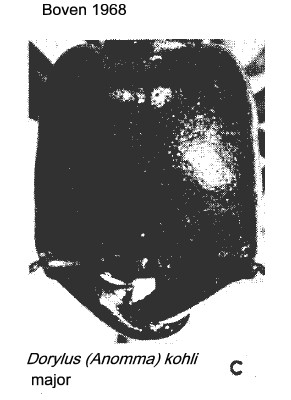 Also
known from Congo (Brazzaville, by A. Weiss), Zaire
(Akenge, Niangara and Avakubi by Lang & Chapin; also St. Gabriel by
Kohl) and Angola (in Wheeler, 1922). Note the variety congolensis
Santschi, listed by Wheeler (1922) was later raised to full species
status by Boven & Lévieux (1970), Dorylus
(Anomma) congolensis, but has its type location as Congo, see
above. Also
known from Congo (Brazzaville, by A. Weiss), Zaire
(Akenge, Niangara and Avakubi by Lang & Chapin; also St. Gabriel by
Kohl) and Angola (in Wheeler, 1922). Note the variety congolensis
Santschi, listed by Wheeler (1922) was later raised to full species
status by Boven & Lévieux (1970), Dorylus
(Anomma) congolensis, but has its type location as Congo, see
above.
The original discoverer, Father Kohl, described the
activities of kohli, noting that it seemed to be primarily
hypogaeic, foraging below the soil surface, unlike the more common
epigaeic habit of (Anomma) driver ants. The Zaïre findings also
were from underneath surface cover. Raignier & van Boven (1955)
confirmed the species migrated in a primarily subterranean way but
found the nests opened with craters and the foragers dispersed on the
surface, using narrow semi-covered trails.
Boven (1968) described the queen found in association
with workers from Mayidi, Congo, collector Rev. Fr. A.
Raignier, 27.ii.1959. He noted the major worker has a near rectangular
head ; the mandibles are curved, semi-matt and with a basal tooth. The
colour of kohli is the same as Dorylus
(Anomma) congolensis but the sculpture is slightly more matt.
The mandible index (MI = head length/mandible length) at 1.67 compares
with MI 1.83 with the congolensis major.
|
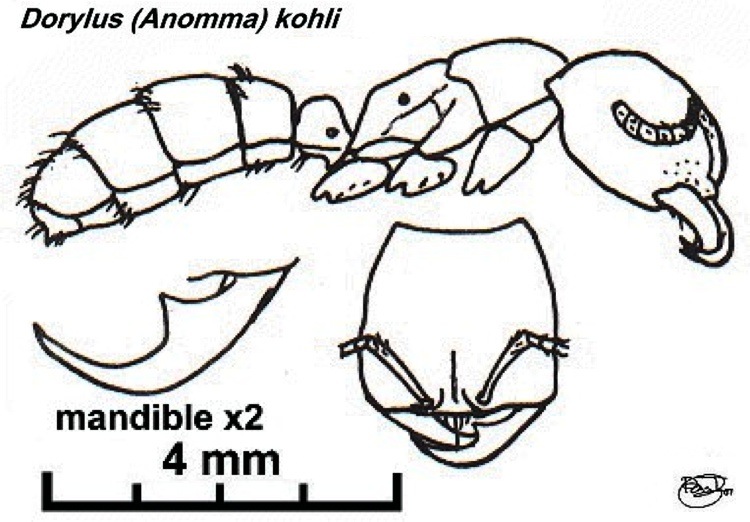 Nigeria
specimens (Taylor, 1980b: 11). WORKERS. TL 9.75-4.18. At least four
morphs; largest HL 2.28, HW 2.34, SL 1.20, PW 1.20, petiole length 0.68 Nigeria
specimens (Taylor, 1980b: 11). WORKERS. TL 9.75-4.18. At least four
morphs; largest HL 2.28, HW 2.34, SL 1.20, PW 1.20, petiole length 0.68
Colour very dark red-brown, lateral alitrunk and legs lighter, anterior
of head and almost all of gaster darkest areas. Minor morphs more
uniformly coloured, the smaller the morph the lighter the colour, with
the smallest more yellow-brown. All over sculpturation of very fine
reticulation; on major head extremely faint but enough to make
appearance glossy rather than polished. Erect hairs on the posterior
margins of gastral segments and subpetiole. Head widest just before
anterior margin, and with posterodorsal lateral triangular tubercles.
Antennal scapes thickening to a broad apex. Mandible highly polished
with a long acute apical tooth and large triangular basal tooth, smooth
margin in between, and sparse long setae on the inner margin . Clypeal
margin near straight but slightly produced centrally and laterally;
with a long medial seta, other hairs short. Promesonotum only slightly
convex dorsally. Subpetiolar process broad based and triangular, with a
slight rearward curve.
I found it nesting in the ground and foraging widely on the surface at
the Cocoa Research Institute of Nigeria, Idi Ayunre. Also known from
Old Calabar (H W Bates, in Forel, 1911, and Wheeler, 1922).
|
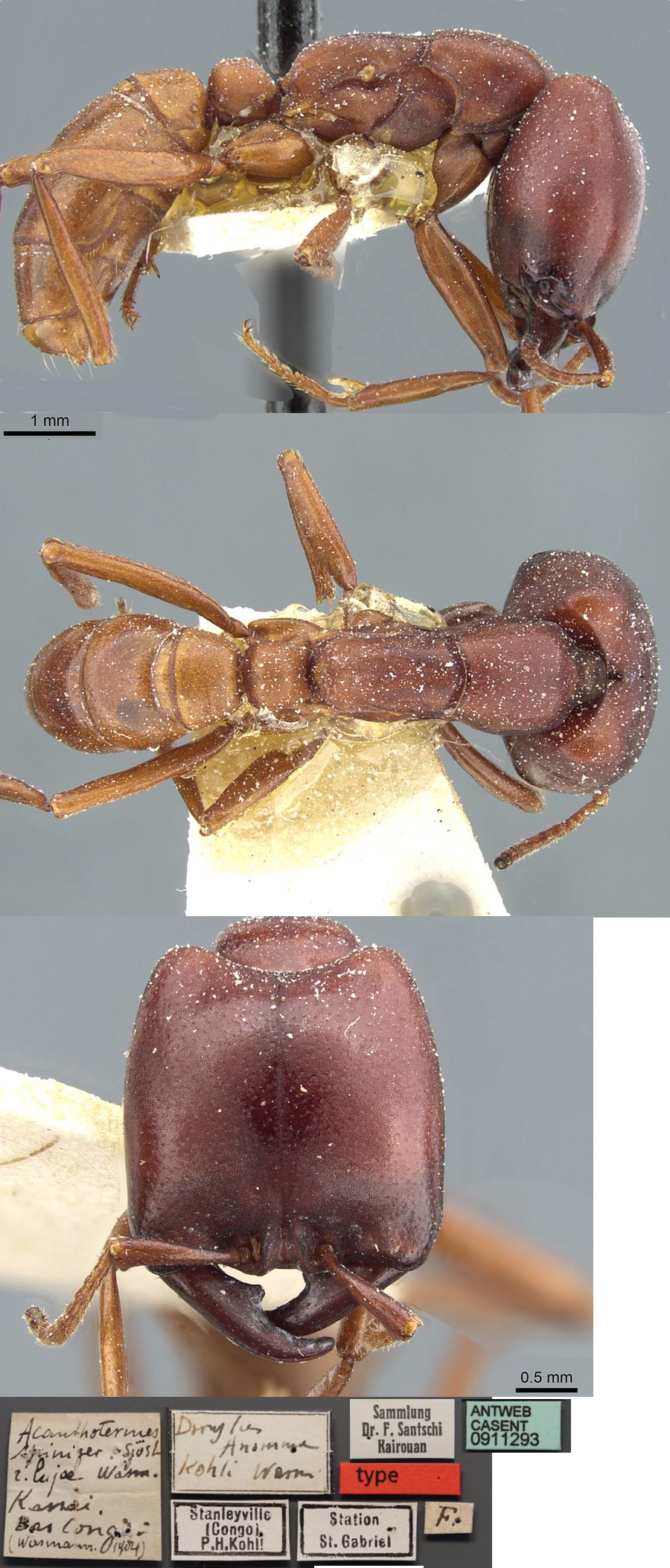 The photomontage of a
type worker is collated from http://www.antweb.org/specimen.do?name=casent0911293.
From the head size and mandible form, with hints of a subapical tooth,
this probably is a media 1 worker and not the major form. The photomontage of a
type worker is collated from http://www.antweb.org/specimen.do?name=casent0911293.
From the head size and mandible form, with hints of a subapical tooth,
this probably is a media 1 worker and not the major form.
|
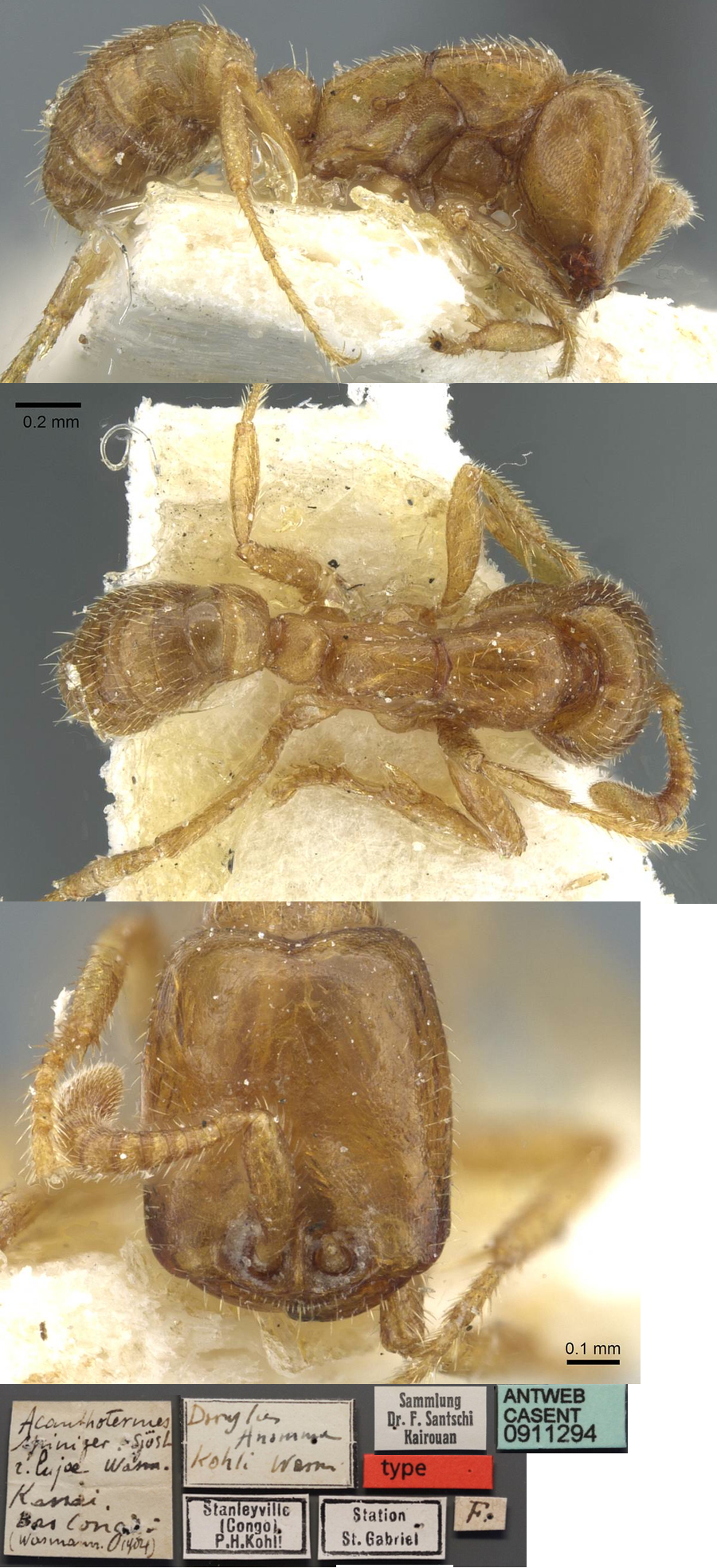 The photomontage of the
type minima (?) worker is collated from http://www.antweb.org/specimen.do?name=casent0911294. The photomontage of the
type minima (?) worker is collated from http://www.antweb.org/specimen.do?name=casent0911294.
|
Oxford University Museum
specimens
Dorylus (Anomma) kohli
B Taylor det.
|
Benin
J-F Vayssieres
RVA 2894
|
13.ix.2012
Korobourou
09°22'13'' N
02°40'16'' E
|
Mangifera indica orchard
Quadrat 4, tube 3, variété: Gouverneur; ground nesting
Major workers
|
2
|
 |
|
 Major
worker. Photomontage of a major worker from Benin, J-F Vayssieres
(RVA
2894); exactly matches the Santschi "type" above Major
worker. Photomontage of a major worker from Benin, J-F Vayssieres
(RVA
2894); exactly matches the Santschi "type" above
|
Wheeler (1922) had the following description of chapini.
Dorylus (Anomma) kohli variety chapini,
new variety.
This is a very distinct form, represented by a series of two dozen
workers from Kisangani, Zaïre (Stanleyville; Lang and Chapin),
without further data.
TL measure 1.5 to 6 mm. The largest specimens are probably not the
maxima forms as they have a preapical mandibular tooth. The body is
only slightly shining and very similar in sculpture to the preceding
variety except that the punctures are coarser, sharper and piligerous.
They are evenly distributed over the dorsal surface of the head and
pronotum, similar but smaller and shallower on the propodeum and
gaster, and very indistinct or absent on the petiole. Mandibles and
legs smooth and shining. The head, pro- and mesonotum, gaster, scapes,
and legs are covered with short, subappressed, yellow hairs arising
from the punctures and forming a conspicuous, rather abundant, coarse
pubescence. The body is brownish ferruginous, the head slightly darker,
and appendages paler, the mandibles blackish. The head is scarcely
longer than broad in front, the sides very feebly convex and converging
to the posterior border, which is only slightly excised and about
four-fifths as long as the anterior border. The petiole is as broad as
long. The smaller workers closely resemble the larger, except that the
head is a little longer and the colour paler.
|
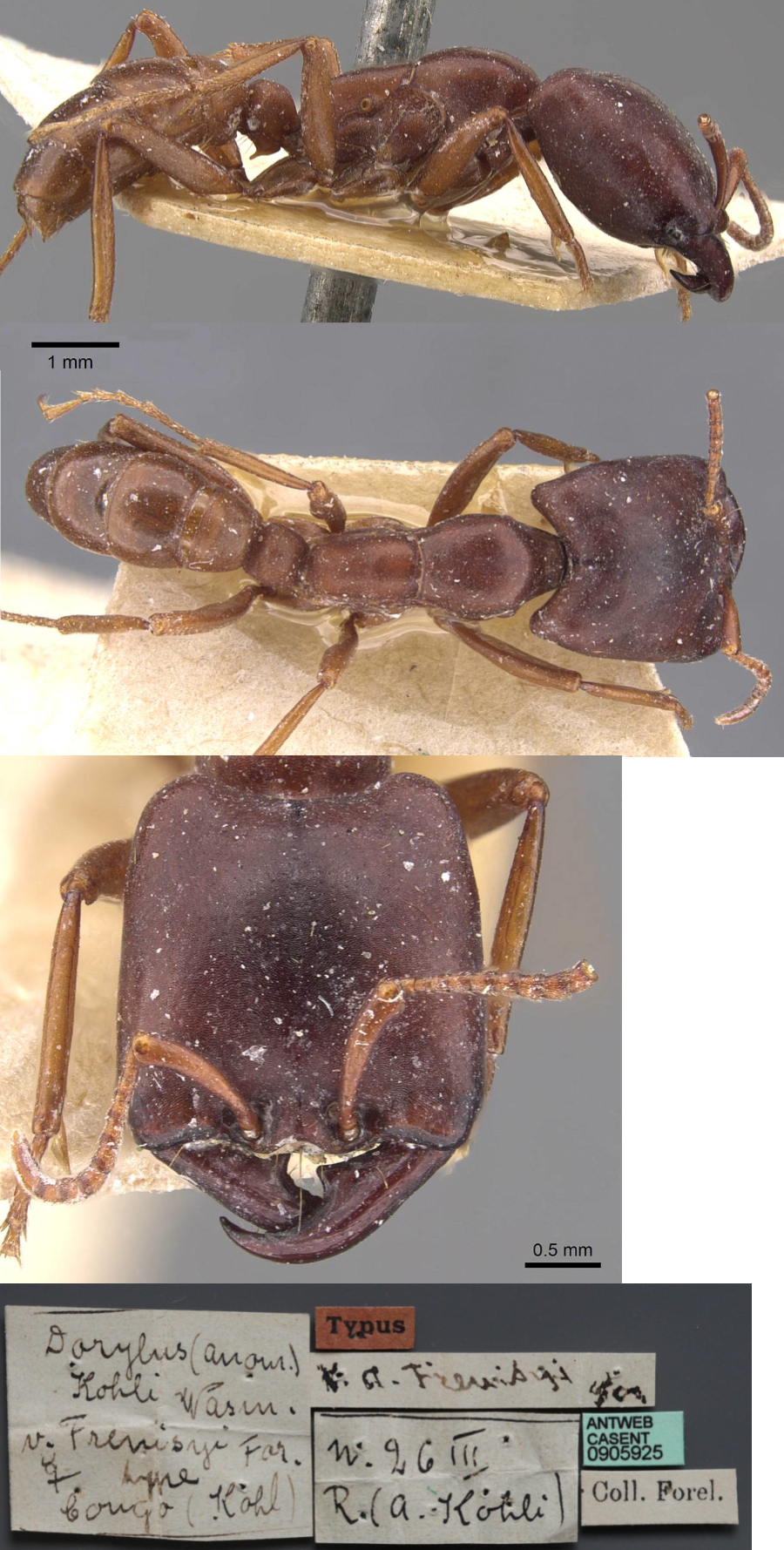 The
photomontage is of a major worker of frenisyi
collated
from http://www.antweb.org/specimen.do?name=casent0905930. The
photomontage is of a major worker of frenisyi
collated
from http://www.antweb.org/specimen.do?name=casent0905930.
|
 This
photomontage of chapini cotypes is collated from The
Smithsonian Institute images at http://ripley.si.edu/ent/nmnhtypedb/public/specimeninfopage.cfm?publicconsumption=1&typespecimenID=984.
The main images appear to be of a media 4 specimen and is similar to
those shown above. This
photomontage of chapini cotypes is collated from The
Smithsonian Institute images at http://ripley.si.edu/ent/nmnhtypedb/public/specimeninfopage.cfm?publicconsumption=1&typespecimenID=984.
The main images appear to be of a media 4 specimen and is similar to
those shown above.
|
|